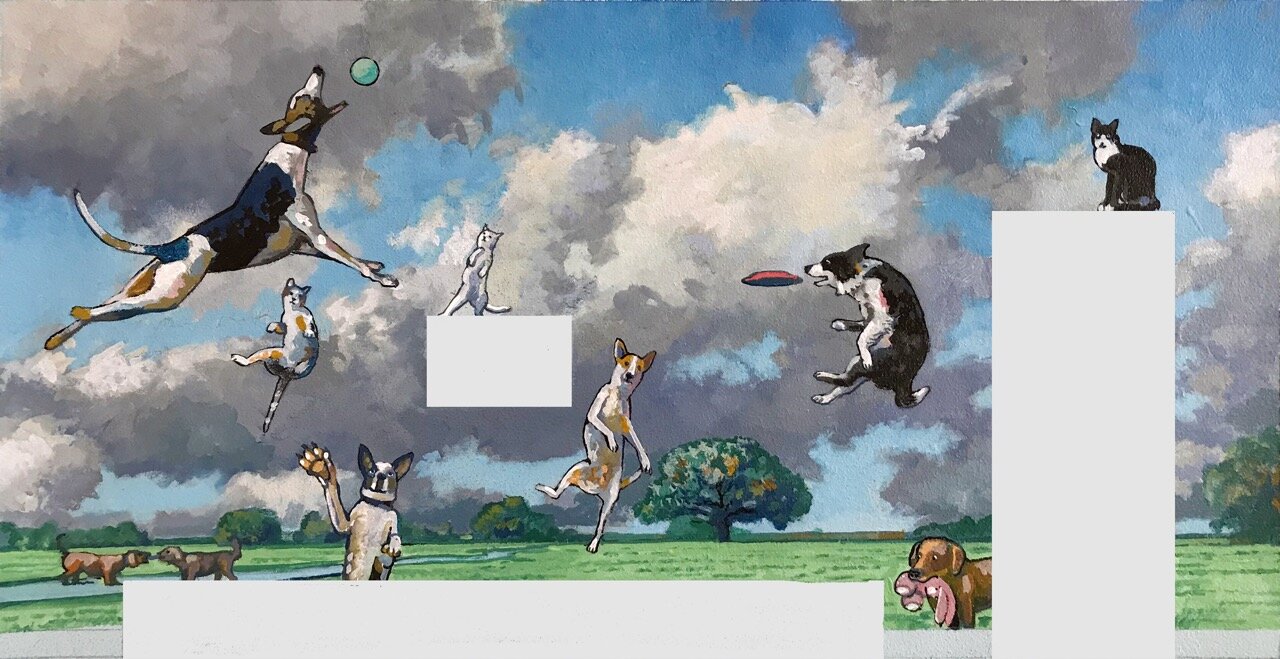Oct, 2022: We are making great progress on the installation! Photos below show the currently installed pieces. Next up, the 3-D, five-foot-tall blue dog sculpture, which will sit on the limestone gabion “selfie bench” in front of the Adoption Center.
This clever mural by California artist John Wehrle of Trout in Hand Studio is a focal point of the Adoption Center lobby.
Luna, Chip and Pepita welcome visitors to the facility.
It’s been more than a year since I was selected by the Fort Worth Arts Council and local stakeholders to create an art program for the new North Animal Control and Service Center Campus in Haslet, Texas. After months of design work, budgeting, prototyping and site visits, we’re almost ready for the final design contract and approval from the Arts Council.
“Ophelia” leads “The Chase,” featuring five running mosaic dogs in stainless steel frames, chasing each other across the campus.
“Savannah” is a fiberglass and Mexican smalti mosaic cat who explores the upper reaches of the Adoption Center.
Color plan for the Blue Dog Selfie Bench.
Wednesday my longtime friend and artist Albert Scherbarth and I visited the site, carrying with us a mock up of an eight-foot-tall gabion and the prototype stainless steel frame for “Pepita,” a chihuahua who would sit atop that tall gabion as an entrance marker. Here are some photos from our visit.
2021 can’t come soon enough, for so many reasons. We’re looking forward to starting our fabrication on this ambitious collection of mosaics and shelter art! Once we get final approval at the January Arts Council meeting, we’re off and running. Special thanks to Alida Labbe, Public Art Project and Capital Budget Manager for the Arts Council of Fort Worth, for her leadership and support as this fun project develops.
Five running mosaic dogs, two-sided, will mount to the retaining wall in front of the Veterinary Clinic and Administration Building.
Our selfie bench and blue dog will be in this left side grassy patch.
Public art muralist John Wehrle is creating a custom wall mural for the Animal Adoption Center lobby. The inspiration is a local prairie landscape filled whimsically with happy, jumping, floating cats and dogs. It’s a little nod to one of my favorite paintes, the Belgian artist Rene Magritte.
Mockup of “Pepita.” We’re changing out the thick stainless steel for a lighter band. The mosaic, made of Eco-Body Quarry Tile, will be flush with the surface of the stainless frame and will be repeated on the back side. Three gabions of different heights will stand as entrance markers.
“Chip” will be the mascot image, a reminder to adopters to have their pets microchipped. He’s one of the three entry gabion pets. A green cat named “Luna” is the third. Albert Scherbarth will be fabricating three gabions and a large, limestone-topped seating gabion, on which will be a six-foot-tall blue dog - a selfie station for residents and their newly-adopted pets.
A few flat mosaic cats will lounge on the I-beams, leading folks to the back room where 30 cat kennels will host felines awaiting adoption.
The cement work and railings aren’t in place yet, but we’ll have a large calico here, encouraging people to walk out to the adoption center patio and walk around the pond trail using the ramp (not pictured). Also a great place for selfies! This building also features a meeting/classroom.
A unique feature of the facility is the bioswale, a marshy, plant-filled area between each kennel building. The runoff from hosing out the kennels will be collected, cleaned naturally and siphoned into the existing pond below.
Dr. Tim Morton, the head veterinarian and director, gave us a hard hat tour. We’re looking out from the second floor of the administration and clinic building, towards the adoption center.
Luna, Chip and Pepita mark the entryway of the NACC facility.
While getting a hard hat tour of the administration and clinic building, I noticed a sublime construction moment. You don’t see many of them.






































